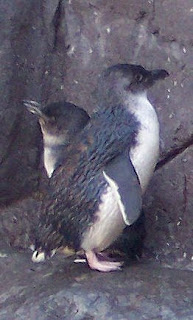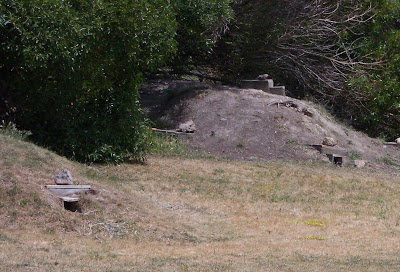 When we think of marine life, we most often think of fish, of course. Next we probably think of invertebrates such as crabs and lobsters, corals, and marine mammals like dolphins and whales. We sometimes overlook the fact that there are many species of birds that qualify as marine life, too.
When we think of marine life, we most often think of fish, of course. Next we probably think of invertebrates such as crabs and lobsters, corals, and marine mammals like dolphins and whales. We sometimes overlook the fact that there are many species of birds that qualify as marine life, too.One kind of marine bird that we are getting to know during our New Zealand trip is the penguin. Until we came to New Zealand, we had never seen a live penguin except at a zoo or marine park. This trip has afforded us our first opportunity to see penguins in the wild.
Several species of penguin make their home on the coasts of New Zealand's South Island, but by some stroke of fate or luck, the first one we are learning about -- and writing about in The Right Blue -- is the Blue Penguin (Eudyptula minor).
 The feathers on the Blue Penguin's back and head really are blue, but they look more blackish when they are wet. They are cute little fellows -- and they are indeed little. In fact the Blues are the smallest penguin species in the world. Adults usually weigh about a kilogram (a little more than two pounds), and they stand about 30 cm (1 foot) tall.
The feathers on the Blue Penguin's back and head really are blue, but they look more blackish when they are wet. They are cute little fellows -- and they are indeed little. In fact the Blues are the smallest penguin species in the world. Adults usually weigh about a kilogram (a little more than two pounds), and they stand about 30 cm (1 foot) tall.Despite their small size, Blue Penguins can swim fast underwater -- about 8 km (5 miles) per hour. They spend most of the daylight hours swimming at sea, diving again and again to catch their prey -- small fish and squid. According to the folks at the Oamaru Blue Penguin Colony, these birds are known to make an average of about 800 dives each day. Each dive lasts about 20-30 seconds, although Blue Penguins are able to hold their breath for up to two minutes.
When they swim on the surface, they assume a prone position that makes them look like chubby ducks. On land they stand upright, and walk in a waddle, rocking back and forth with each step.
 Penguins' wings are used to propel them when they swim underwater. When they walk on land, they tend to hold out their wings to help balance. They are not able to fly.
Penguins' wings are used to propel them when they swim underwater. When they walk on land, they tend to hold out their wings to help balance. They are not able to fly.Their natural predators at sea are sharks, killer whales, sea lions, and leopard seals. On land they are sometimes killed by ferrets, dogs, and other predatory mammals. Like other marine animals, Blue Penguins also face man-made dangers. They sometimes become entangled in fishing gear and other marine debris, and their nesting grounds are damaged and encroached upon by people and pets.
Approximately 200 Blue Penguins make their home in an area near the port of Oamaru -- situated on the South Island's east coast, about an hour's drive north of the city of Dunedin. Volunteers have provided the Oamaru Blue Penguin colony with nesting boxes in artificial burrows (see photo below). Access to the area is restricted during the hours when most of the birds come ashore to rest and feed their chicks.
They come ashore each evening at dusk, and spend the night on land in burrows where they nest. At dawn they emerge from their burrows and return to the sea to find their food, often ranging as much as 25 km (about 15 miles) offshore in the course of a day's swim.
 To see more detail, click on any of the photos to enlarge.
To see more detail, click on any of the photos to enlarge.

BNSullivan.jpg)
BNSullivan465x300.jpg)
BNSullivan.jpg)


BNSullivan.jpg)

Nice explanation and pictures. They do seem duck like.Glad to see they are surviving with some help from their friends.
ReplyDeleteYou can see the blue feathers really well in the second photo.
ReplyDeleteThey certainly are busy - are they tending their chicks now? That will keep them even busier!
Great post!
Thank you, Danny. The Blue Penguins do seem to be faring better than some of the other penguin species.
ReplyDeleteKathy, yes, they are tending chicks now. If I remember correctly, a woman who works at the Oamaru Blue Penguin colony told us that there are about 100 chicks there this year.
Bobbie
Very cool and informative post! Stumbled.
ReplyDelete-Thomas of Photos from Northern Norway
Wonderful post and it was great learning about a bird that I never knew about. Thanks for sharing!
ReplyDeleteBobbie, ohhhhh they are so cute. I actually love penguins - did you ever watch the happy feet; and there was another documentary I watched narrated by Morgan Freeman, it was really good - not the same type though. The ever closest encounter I had, it was always at the zoo, hey still real thing. Lovely photos and very good information about them. As much as it is part of food chain, I hate to think about the predators, but what can you do. Great post, and thanks for the visit on my blog. Anna :)
ReplyDelete...oh just back for the email follow up, lol. Anna :)
ReplyDeleteThomas, thank you - and thanks for the Stumble, too.
ReplyDeleteMon@rch, we never knew about this bird before we saw it here, either. Glad you enjoyed the post.
Anna, we did see both of those films you mentioned. I think those were about Emperor penguins in Antarctica. I believe the Emperors are the largest penguin species, while the Blues are the smallest.
Bobbie
More articles on seabirds, please! :)
ReplyDeleteWe arrived at Oamaru at the wrong time (an hour early, I think). However, we were lucky to see a few in nesting boxes when we visited Penguin Place to view the yellow-eyed penguins.
Hi Lavender - You're right. I really should do more articles on sea birds. I've been neglectful of this form of marine life!
ReplyDeleteBobbie
Great photos and information on your viewing of the Blue penguins. I really do hope we get to see them when we are in New Zealand this October. I also want to see the Albatross as well!
ReplyDeleteDont you just love th elittle creatures!!!!! they are sooo adorable! can you help me for a science poster on blue penguins? how do they respirate? im not quite sure what it means so any help would be nice!!! thanks! :D
ReplyDeletehaha i forgot to put my name! the one about the science poster is me!!
ReplyDeletexoxo :D Jessica
Hi Jessica -
ReplyDeleteTo respirate means to breathe. Penguins are birds, and they are air breathers. Just like you and me, they hold their breath when they dive under the water, and breathe again when they come back to the surface.
Thanks for this info. It helped me a lot with my research paper and I got to see how they looked.
ReplyDelete